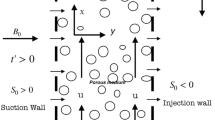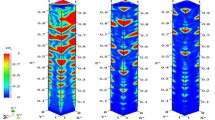Abstract
Simultaneous hydrodynamic and thermal development of a laminar flow due to superimposed natural and forced convection in an isothermal vertical pipe is investigated numerically. The distinct feature of the computational procedure is that it uses the method of lines, wherein the Navier-Stokes equations accounting for buoyancy and constant properties are reduced to a system of first order ordinary differential equations. The latter is readily solved by a standard fourth-order Runge-Kutta technique. The paper includes a detailed discussion of the proposed methodology, and in addition to this, it provides the distributions of velocities, pressure and temperature. All calculations are based on a coarse grid with ten lines uniformly distributed in the cross-stream direction of the pipe when the velocity profile at the entrance is assumed parabolic. Computed results accounting for both upflow and downflow situations are in good agreement with other more elaborate numerical investigations and also with available experimental data employing air and water as working fluids.
Zusammenfassung
Die simultane hydrodynamische und thermische Entwicklung einer laminaren Strömung infolge der Uberlagerung von freier und erzwungener Konvektion in einem isothermen senkrechten Rohr wird numerisch untersucht. Die besondere Eigenschaft der rechnerischen Prozedur ist, daß diese die Method of lines“ benutzt, worin die Navier-Stokes-Gleichungen für Antrieb bei konstanten Stoffwerten zu einem System einfacher Differentialgleichungen erster Ordnung reduziert werden. Das letztere ist ohne weiteres mit der Runge-Kutta-Technik 4. Ordnung zu lösen. Die Untersuchung beinhaltet eine detaillierte Diskussion der vorgeschlagenen Methodik und in Anfügung an diese liefert es die Verteilung von Geschwindigkeiten, Druck und Temperatur. Alle Kalkulationen basieren auf einem groben Gitter mit 10 Linien, die einheitlich in der Querstromrichtung des Rohres verteilt sind, wenn das Geschwindigkeitsprofil am Eingang des Rohres parabolisch angenommen wird. Die errechneten Ergebnisse, die sowohl für Aufwärts- als auch Abwärtsströmungen gelten, stimmen gut mit anderen aufwendigen Untersuchungen und ebenso mit verfügbaren experimentellen Daten, die Luft und Wasser als Arbeitsfluide gebrauchen, überein.
Similar content being viewed by others
Abbreviations
- c p :
-
specific heat at constant pressure
- f ap :
-
apparent friction coefficient, Eq. (23)
- Gr :
-
Grashof number,gβ(Tw−To) R3/v2
- g :
-
acceleration of gravity
- h :
-
convection coefficient
- k :
-
thermal conductivity
- l :
-
tube length
- L:
-
parameter related to the sign of the buoyancy term, Eq. (3)
- m :
-
mass flow rate
- Nu :
-
local Nusselt number, 2hR/k
- n :
-
number of lines
- p :
-
pressure
- P :
-
dimensionless pressure, (p-p o -ϱgx L)/ϱ U 2m
- Pe :
-
Peclet number, 2U m R/α
- Pr :
-
Prandtl number,μc p /k
- Q T :
-
total heat transfer
- r :
-
radial coordinate
- R :
-
radius
- Re :
-
Reynolds number,2U m R/v
- rT :
-
temperature
- u :
-
xial velocity
- U :
-
dimensionless axial velocity,u/U m
- v :
-
radial velocity
- V :
-
dimensionless radial velocity,v/U m
- x :
-
axial coordinate
- Z:
-
dimensionless axial coordinate,x/R
- α :
-
thermal diffusivity
- β :
-
coefficient of thermal expansion, (l/ϱ)(∂)p
- η :
-
dimensionless radial coordinate,r/R
- θ :
-
dimensionless temperature, (T - Tw)/(To - Tw)
- v :
-
kinematic viscosity
- Ω :
-
dimensionless heat transfer, Eq. (25 a)
- ϱ :
-
density
- ψ :
-
generalized variables, Eq. (28)
- b :
-
mean bulk
- c :
-
center
- i :
-
line
- m:
-
mean
- 0:
-
entrance
- w :
-
wall
References
Martinelli, R. C.; Boelter, L. M. K.: An analytical prediction of superimposed free and forced viscous convection in a vertical pipe. Univ. Calif. Berkeley Publ. Eng. 24 (1942) 393–400
Martinelli, R. C.; Boelter, L. M. K.: Heat transfer and pressure drop for a fluid flowing in the viscous region through a vertical pipe. Trans. AIChE 38 (1942) 493–530
Pigford, R. L.: Nonisothermal flow and heat transfer inside vertical tubes. Chem. Eng. Progr. Symp. Ser. 51 (1955) 79–92
Rosen, E. M.; Hanratty, T. J.: Use of boundary-layer theory to predict the effect of heat transfer on the laminar flow field in a vertical tube with a constant temperature wall. AIChE J. 7 (1961) 112–123
Marner, W. J.: Combined free and forced laminar nonNewtonian convection in a vertical tube. Ph.D. Thesis Univ. of South Carolina 1969
Marner, W. J.; McMillan, H. R.: Combined free and forced lamiar convection in a vertical tube with constant wall temperature. J. Heat Tranfer (1970) 559–562
Zeldin, B.; Schmidt, F. W.: Developing flow with combined force-free convection in an isothermal vertical tube. J. Heat Transfer (1972) 211–223
Collins, M. W.: Finite-difference analysis for developing laminar flow in circular tubes applied to forced and combined convection. Int. J. Num. Meth. Eng. 15 (1980) 381–404
Suzuki, K.; Kieda, S.; Chichiki, T.; Sato, T.: Numerical study of combined convective heat transfer with variable fluid properties in the inlet region of a circular pipe. Int. Conf. of Numerical Methods in Thermal Problems, Venice, Italy, 1981
Shaddy, M. A.: Combined forced-free convection through vertical tubes at high Grashof numbers. Int. Heat Transfer Conference 3 (1986) 1433–1438, Munich, FRG
Liskovets, D. A.: The method of lines (review). Differential Equations 1 (1965) 1308–1323
Campo, A.; Lacoa, U.; Morales, J. C: Semi-analytical computation for laminar flow in the thermal entrance region of circular tubes. To appear in Int. J. Mech. Eng. Education 1987
Campo, A.; Schuler, C: Thermal radiation and laminar forced convection in a gas pipe flow. Wärme-Stoffübertrag. 22 (1988) 251–257
Campo, A.: El metodo de las lineas aplicado al desarrollo termohidráulico en tubos isotérmicos. To appear in Revista Internacional de Métodos Numéricos en Ingenieria, 1988
Marner, W. J.: Written discussion of Ref. [7]
Shah, R. K.: Thermal entry length solutions to the circular tube and parallel plates. National Heat Transfer Conference, Bombay, India, 1975
Author information
Authors and Affiliations
Rights and permissions
About this article
Cite this article
Campo, A. Numerical prediction of combined laminar convection in isothermal vertical tubes via the method of lines. Wärme- und Stoffübertragung 23, 239–247 (1988). https://doi.org/10.1007/BF01807327
Received:
Issue Date:
DOI: https://doi.org/10.1007/BF01807327




